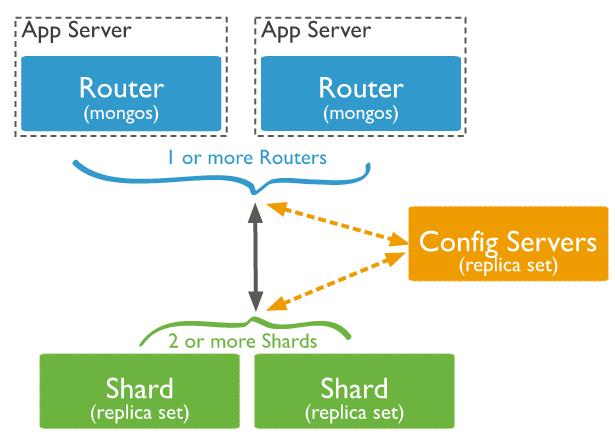前言
最近因為工作的原因,在學習使用mongodb數據庫,mongodb是最常用的nodql數據庫,在數據庫排名中已經上升到了前六。這篇文章介紹如何搭建高可用的mongodb(分片+副本)集群,分享出來供大家參考學習,下面話不多說了,來一起看看詳細的介紹:
在搭建集群之前,需要首先了解幾個概念:路由,分片、副本集、配置服務器等。
相關概念
先來看一張圖:

從圖中可以看到有四個組件:mongos、config server、shard、replica set。
mongos,數據庫集群請求的入口,所有的請求都通過mongos進行協調,不需要在應用程序添加一個路由選擇器,mongos自己就是一個請求分發中心,它負責把對應的數據請求請求轉發到對應的shard服務器上。在生產環境通常有多mongos作為請求的入口,防止其中一個掛掉所有的mongodb請求都沒有辦法操作。
config server,顧名思義為配置服務器,存儲所有數據庫元信息(路由、分片)的配置。mongos本身沒有物理存儲分片服務器和數據路由信息,只是緩存在內存里,配置服務器則實際存儲這些數據。mongos第一次啟動或者關掉重啟就會從 config server 加載配置信息,以后如果配置服務器信息變化會通知到所有的 mongos 更新自己的狀態,這樣 mongos 就能繼續準確路由。在生產環境通常有多個 config server 配置服務器,因為它存儲了分片路由的元數據,防止數據丟失!
shard,分片(sharding)是指將數據庫拆分,將其分散在不同的機器上的過程。將數據分散到不同的機器上,不需要功能強大的服務器就可以存儲更多的數據和處理更大的負載。基本思想就是將集合切成小塊,這些塊分散到若干片里,每個片只負責總數據的一部分,最后通過一個均衡器來對各個分片進行均衡(數據遷移)。
replica set,中文翻譯副本集,其實就是shard的備份,防止shard掛掉之后數據丟失。復制提供了數據的冗余備份,并在多個服務器上存儲數據副本,提高了數據的可用性, 并可以保證數據的安全性。
仲裁者(Arbiter),是復制集中的一個MongoDB實例,它并不保存數據。仲裁節點使用最小的資源并且不要求硬件設備,不能將Arbiter部署在同一個數據集節點中,可以部署在其他應用服務器或者監視服務器中,也可部署在單獨的虛擬機中。為了確保復制集中有奇數的投票成員(包括primary),需要添加仲裁節點做為投票,否則primary不能運行時不會自動切換primary。
簡單了解之后,我們可以這樣總結一下,應用請求mongos來操作mongodb的增刪改查,配置服務器存儲數據庫元信息,并且和mongos做同步,數據最終存入在shard(分片)上,為了防止數據丟失同步在副本集中存儲了一份,仲裁在數據存儲到分片的時候決定存儲到哪個節點。
環境準備
- 系統系統 centos6.5
- 三臺服務器:192.168.0.75/84/86
- 安裝包: mongodb-linux-x86_64-3.4.6.tgz
服務器規劃
| 服務器75 | 服務器84 | 服務器86 |
|---|---|---|
| mongos | mongos | mongos |
| config server | config server | config server |
| shard server1 主節點 | shard server1 副節點 | shard server1 仲裁 |
| shard server2 仲裁 | shard server2 主節點 | shard server2 副節點 |
| shard server3 副節點 | shard server3 仲裁 | shard server3 主節點 |
端口分配:
|
1
2
3
4
5
|
mongos:20000config:21000shard1:27001shard2:27002shard3:27003 |
集群搭建
1、安裝mongodb
|
1
2
3
4
|
#解壓tar -xzvf mongodb-linux-x86_64-3.4.6.tgz -C /usr/local/#改名mv mongodb-linux-x86_64-3.4.6 mongodb |
分別在每臺機器建立conf、mongos、config、shard1、shard2、shard3六個目錄,因為mongos不存儲數據,只需要建立日志文件目錄即可。
|
1
2
3
4
5
6
7
8
9
10
|
mkdir -p /usr/local/mongodb/confmkdir -p /usr/local/mongodb/mongos/logmkdir -p /usr/local/mongodb/config/datamkdir -p /usr/local/mongodb/config/logmkdir -p /usr/local/mongodb/shard1/datamkdir -p /usr/local/mongodb/shard1/logmkdir -p /usr/local/mongodb/shard2/datamkdir -p /usr/local/mongodb/shard2/logmkdir -p /usr/local/mongodb/shard3/datamkdir -p /usr/local/mongodb/shard3/log |
配置環境變量
|
1
2
3
4
5
6
|
vim /etc/profile# 內容export MONGODB_HOME=/usr/local/mongodbexport PATH=$MONGODB_HOME/bin:$PATH# 使立即生效source /etc/profile |
2、config server配置服務器
mongodb3.4以后要求配置服務器也創建副本集,不然集群搭建不成功。
添加配置文件
|
1
2
3
4
5
6
7
8
9
10
11
12
13
14
15
16
17
18
19
20
|
vi /usr/local/mongodb/conf/config.conf## 配置文件內容pidfilepath = /usr/local/mongodb/config/log/configsrv.piddbpath = /usr/local/mongodb/config/datalogpath = /usr/local/mongodb/config/log/congigsrv.loglogappend = true bind_ip = 0.0.0.0port = 21000fork = true #declare this is a config db of a cluster;configsvr = true#副本集名稱replSet=configs #設置最大連接數maxConns=20000 |
啟動三臺服務器的config server
|
1
|
mongod -f /usr/local/mongodb/conf/config.conf |
登錄任意一臺配置服務器,初始化配置副本集
|
1
2
3
4
5
6
7
8
9
10
11
12
13
14
|
#連接mongo --port 21000#config變量config = {... _id : "configs",... members : [... {_id : 0, host : "192.168.0.75:21000" },... {_id : 1, host : "192.168.0.84:21000" },... {_id : 2, host : "192.168.0.86:21000" }... ]... }#初始化副本集rs.initiate(config) |
其中,”_id” : “configs”應與配置文件中配置的 replicaction.replSetName 一致,”members” 中的 “host” 為三個節點的 ip 和 port
3、配置分片副本集(三臺機器)
設置第一個分片副本集
配置文件
|
1
2
3
4
5
6
7
8
9
10
11
12
13
14
15
16
17
18
19
20
21
22
23
24
25
|
vi /usr/local/mongodb/conf/shard1.conf#配置文件內容#——————————————–pidfilepath = /usr/local/mongodb/shard1/log/shard1.piddbpath = /usr/local/mongodb/shard1/datalogpath = /usr/local/mongodb/shard1/log/shard1.loglogappend = truebind_ip = 0.0.0.0port = 27001fork = true #打開web監控httpinterface=truerest=true #副本集名稱replSet=shard1 #declare this is a shard db of a cluster;shardsvr = true #設置最大連接數maxConns=20000 |
啟動三臺服務器的shard1 server
|
1
|
mongod -f /usr/local/mongodb/conf/shard1.conf |
登陸任意一臺服務器,初始化副本集
|
1
2
3
4
5
6
7
8
9
10
11
12
13
14
|
mongo --port 27001#使用admin數據庫use admin#定義副本集配置,第三個節點的 "arbiterOnly":true 代表其為仲裁節點。config = {... _id : "shard1",... members : [... {_id : 0, host : "192.168.0.75:27001" },... {_id : 1, host : "192.168.0.84:27001" },... {_id : 2, host : "192.168.0.86:27001” , arbiterOnly: true }... ]... }#初始化副本集配置rs.initiate(config); |
設置第二個分片副本集
配置文件
|
1
2
3
4
5
6
7
8
9
10
11
12
13
14
15
16
17
18
19
20
21
22
23
24
25
|
vi /usr/local/mongodb/conf/shard2.conf#配置文件內容#——————————————–pidfilepath = /usr/local/mongodb/shard2/log/shard2.piddbpath = /usr/local/mongodb/shard2/datalogpath = /usr/local/mongodb/shard2/log/shard2.loglogappend = truebind_ip = 0.0.0.0port = 27002fork = true #打開web監控httpinterface=truerest=true #副本集名稱replSet=shard2 #declare this is a shard db of a cluster;shardsvr = true #設置最大連接數maxConns=20000 |
啟動三臺服務器的shard2 server
|
1
|
mongod -f /usr/local/mongodb/conf/shard2.conf |
登陸任意一臺服務器,初始化副本集
|
1
2
3
4
5
6
7
8
9
10
11
12
13
14
15
|
mongo --port 27002#使用admin數據庫use admin#定義副本集配置config = {... _id : "shard2",... members : [... {_id : 0, host : "192.168.0.75:27002" , arbiterOnly: true },... {_id : 1, host : "192.168.0.84:27002" },... {_id : 2, host : "192.168.0.86:27002" }... ]... }#初始化副本集配置rs.initiate(config); |
設置第三個分片副本集
配置文件
|
1
2
3
4
5
6
7
8
9
10
11
12
13
14
15
16
17
18
19
20
21
22
23
24
25
26
|
vi /usr/local/mongodb/conf/shard3.conf #配置文件內容#——————————————–pidfilepath = /usr/local/mongodb/shard3/log/shard3.piddbpath = /usr/local/mongodb/shard3/datalogpath = /usr/local/mongodb/shard3/log/shard3.loglogappend = truebind_ip = 0.0.0.0port = 27003fork = true #打開web監控httpinterface=truerest=true #副本集名稱replSet=shard3 #declare this is a shard db of a cluster;shardsvr = true #設置最大連接數maxConns=20000 |
啟動三臺服務器的shard3 server
|
1
|
mongod -f /usr/local/mongodb/conf/shard3.conf |
登陸任意一臺服務器,初始化副本集
|
1
2
3
4
5
6
7
8
9
10
11
12
13
14
15
|
mongo --port 27003#使用admin數據庫use admin#定義副本集配置config = {... _id : "shard3",... members : [... {_id : 0, host : "192.168.0.75:27003" },... {_id : 1, host : "192.168.0.84:27003" , arbiterOnly: true},... {_id : 2, host : "192.168.0.86:27003" }... ]... }#初始化副本集配置rs.initiate(config); |
4、配置路由服務器 mongos
先啟動配置服務器和分片服務器,后啟動路由實例啟動路由實例:(三臺機器)
|
1
2
3
4
5
6
7
8
9
10
11
12
13
14
15
16
|
vi /usr/local/mongodb/conf/mongos.conf#內容pidfilepath = /usr/local/mongodb/mongos/log/mongos.pidlogpath = /usr/local/mongodb/mongos/log/mongos.loglogappend = truebind_ip = 0.0.0.0port = 20000fork = true#監聽的配置服務器,只能有1個或者3個 configs為配置服務器的副本集名字configdb = configs/192.168.0.75:21000,192.168.0.84:21000,192.168.0.86:21000 #設置最大連接數maxConns=20000 |
啟動三臺服務器的mongos server
|
1
|
mongod -f /usr/local/mongodb/conf/mongos.conf |
5、啟用分片
目前搭建了mongodb配置服務器、路由服務器,各個分片服務器,不過應用程序連接到mongos路由服務器并不能使用分片機制,還需要在程序里設置分片配置,讓分片生效。
登陸任意一臺mongos
|
1
2
3
4
5
6
7
8
9
|
mongo --port 20000#使用admin數據庫user admin#串聯路由服務器與分配副本集sh.addShard("shard1/192.168.0.75:27001,192.168.0.84:27001,192.168.0.86:27001")sh.addShard("shard2/192.168.0.75:27002,192.168.0.84:27002,192.168.0.86:27002")sh.addShard("shard3/192.168.0.75:27003,192.168.0.84:27003,192.168.0.86:27003")#查看集群狀態sh.status() |
6、測試
目前配置服務、路由服務、分片服務、副本集服務都已經串聯起來了,但我們的目的是希望插入數據,數據能夠自動分片。連接在mongos上,準備讓指定的數據庫、指定的集合分片生效。
|
1
2
3
4
|
#指定testdb分片生效db.runCommand( { enablesharding :"testdb"});#指定數據庫里需要分片的集合和片鍵db.runCommand( { shardcollection : "testdb.table1",key : {id: 1} } ) |
我們設置testdb的 table1 表需要分片,根據 id 自動分片到 shard1 ,shard2,shard3 上面去。要這樣設置是因為不是所有mongodb 的數據庫和表 都需要分片!
測試分片配置結果
|
1
2
3
4
5
6
7
8
9
10
11
12
13
14
15
16
17
18
19
20
21
22
23
24
25
26
27
28
29
30
31
32
33
34
35
36
37
38
39
40
41
42
43
44
45
46
47
48
49
|
mongo 127.0.0.1:20000#使用testdbuse testdb;#插入測試數據for (var i = 1; i <= 100000; i++)db.table1.save({id:i,"test1":"testval1"});#查看分片情況如下,部分無關信息省掉了db.table1.stats();{ "sharded" : true, "ns" : "testdb.table1", "count" : 100000, "numExtents" : 13, "size" : 5600000, "storageSize" : 22372352, "totalIndexSize" : 6213760, "indexSizes" : { "_id_" : 3335808, "id_1" : 2877952 }, "avgObjSize" : 56, "nindexes" : 2, "nchunks" : 3, "shards" : { "shard1" : { "ns" : "testdb.table1", "count" : 42183, "size" : 0, ... "ok" : 1 }, "shard2" : { "ns" : "testdb.table1", "count" : 38937, "size" : 2180472, ... "ok" : 1 }, "shard3" : { "ns" : "testdb.table1", "count" :18880, "size" : 3419528, ... "ok" : 1 } }, "ok" : 1} |
可以看到數據分到3個分片,各自分片數量為: shard1 “count” : 42183,shard2 “count” : 38937,shard3 “count” : 18880。已經成功了!
后期運維
啟動關閉
mongodb的啟動順序是,先啟動配置服務器,在啟動分片,最后啟動mongos.
|
1
2
3
4
5
|
mongod -f /usr/local/mongodb/conf/config.confmongod -f /usr/local/mongodb/conf/shard1.confmongod -f /usr/local/mongodb/conf/shard2.confmongod -f /usr/local/mongodb/conf/shard3.confmongod -f /usr/local/mongodb/conf/mongos.conf |
關閉時,直接killall殺掉所有進程
|
1
2
|
killall mongodkillall mongos |
總結
以上就是這篇文章的全部內容了,希望本文的內容對大家的學習或者工作能帶來一定的幫助,如果有疑問大家可以留言交流,謝謝大家對服務器之家的支持。
參考:
- 搭建高可用mongodb集群(四)—— 分片
- MongoDB3.4副本集分片集群搭建
- Mongodb高可用集群(四)——分片
原文鏈接:http://www.ityouknow.com/mongodb/2017/08/05/mongodb-cluster-setup.html















